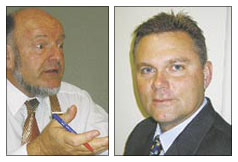Leaders keen to progress UDS
 Getting four councils and Transit New Zealand to agree and draft an Urban Development Strategy (UDS) to deal with future growth in Greater Christchurch is not impossible or difficult, say the consultants leading the project. Getting four councils and Transit New Zealand to agree and draft an Urban Development Strategy (UDS) to deal with future growth in Greater Christchurch is not impossible or difficult, say the consultants leading the project.
Ken Tremaine and Bill Wasley have been taken on as joint project leaders to help implement the UDS — Mr Tremaine, from Auckland, as technical specialist and Mr Wasley, from Tauranga, the governance specialist.

Ken Tremaine (left); Bill Wasley (right)
Between them, they have managed the successful Bay of Plenty Smartgrowth project that Prime Minister Helen Clark launched on 14 May, 2004. Smartgrowth was set up to ensure that as Western Bay of Plenty grows, it continues to be a great place to live, work and play.
The two helped Tauranga City, the Western Bay of Plenty District Council, and Bay of Plenty Regional Council draft and implement a Western Bay of Plenty strategic growth management plan. The Government was impressed enough to match dollar-for-dollar Western Bay of Plenty's clean transport plan for 10 years, netting a total of $300 million for the sub- region's transport.
"My big interest is in big-scale development planning in New Zealand and internationally, to look long-term at land use and the social implications of that in housing, health, transport and a fair means of funding this," Mr Tremaine says. "In the past, New Zealand has not been too good at knowing the cost of growth or delivering timely zoning and infrastructure at a fair price to support it."
Long-term strategising is a major learning curve for Canterbury authorities, whose representatives must ignore historical boundaries to plan and seek solutions, and for Central Government, which gets nervous when individual local governments seek funds for infrastructure.
"It's about connecting the head, heart, and funding. You collate the great ideas, build community passion for it, then seek the means to deliver it," Mr Tremaine says.
"Smartgrowth attracted Central Government funding because it provided a growth-management strategy that all agreed to, then identified key infrastructural needs and practical solutions that could be achieved with adequate funding," he says.
Mr Wasley says his challenge is to keep all the Greater Christchurch partners fully engaged in the process. "That won't always be easy, but it is achievable and realistic," he says. "It will take time because it's about understanding each others' issues and positions, but developing trust to consider what's best for the metropolitan sub-region as a whole.
"It is about nurturing a culture of partnership and collaboration on a long-term basis. Working together sends all the right signals to Government that the Greater Christchurch partners can deliver together long term," Mr Wasley says. "It's about having a metropolitan sub-regional vision, which is both urban and rural, but shares similar goals of safe, vibrant communities with a sense of place, a means of getting around easily, clean water and air, and a variety of sustainable, affordable housing."
Timeline for Greater Christchurch UDS
| Stage One |
| Strategy drafting |
Mid March to late April 2006 |
| Urban development design and planning process |
Late April to end of May 2006 |
| Elected members and UDS Forum input (between conclusion of charette and draft strategy) |
End of May to end of June 2006 |
| First draft of Urban Development Strategy |
End of June 2006 |
| Activity Manager sign-off. Confirmation of draft Urban Development Strategy by key activity and asset managers from all Greater Christchurch UDS partners |
Mid July 2006 |
| Elected Member and UDS Forum Engagement (pre-Strategy notification review) |
August 2006 |
| Notification of the draft Greater Christchurch Urban Development Strategy after UDS partners agree to release it for public consultation |
End of August to mid September 2006 |
| Review project time line |
End of August |
| Stage Two |
| Public consultation |
Mid September to mid October, 2006 |
| Submissions close Analysis, hearings, strategy modification |
Mid November to mid December, 2006 |
| Elected members and UDS Forum engagement |
December to mid February 2007 |
| Implementation: Ongoing work on Strategy actions, formal implementation structure agreed to, monitoring framework put into place |
February to April 2007 |
| Implementation tools: LTCCP amendment, Regional Planning Strategy scope, and Regional Land Transport Strategy alignment |
May to June 2007 |
|